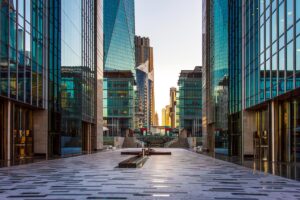Look back on the last half a century and you’ll find that Dubai is the fastest growing city on the planet. What was once a small fishing town of 20,000 people in 1960 has since grown 175 times in size, housing millions of people from around the world.
This growth has been influenced by a number of key events in the region. First, the discovery of oil in the late 1950s attracted foreign investment and pushed forward significant economic and infrastructural development. The 1980s, meanwhile, spelled diversification as the city built the Jebel Ali Port and became a re-export centre for Central Asia, the Middle East, and Africa. Since then, Dubai has become synonymous with opportunity and innovation — and businesses continue to flock there to expand and tap into new markets.
Today, the city has a population of 3.5 million, representing more than a third of the UAE’s total population. And it’s not stopping there.
The city has estimated that by 2040, Dubai will reach a population of 5.8 million, almost doubling the number of people that live there currently. This anticipated growth prompted the development of the Dubai 2040 Urban Master Plan, which was unveiled by the Prime Minister of the UAE and Ruler of Dubai, Sheikh Mohammed bin Rashid, in 2021. In it, he outlines a plan which will see a massive investment in sustainably growing the city to meet the needs of its citizens and spur ongoing development.
For both established and new businesses in this region, the city’s continued growth over the next two decades spells significant potential. Whether it’s by contributing to new real estate development, enabling digital transformation and innovation, or investing in the expansion of the health sector, among many other projects, opportunities abound.
Expanding Dubai’s infrastructure: The vision for 2040
The Dubai 2040 Urban Master Plan is an exciting one for businesses — whether they have a presence in Dubai yet or not. Its goals are bold: to transform the emirate and create a truly interconnected, people-led city that balances community with tourism and modernity with heritage and nature. In other words, the city is working hard to meet the economic, cultural, and infrastructural needs of their growing population while also putting Dubai at the forefront of innovation and sustainability.
Let’s take a look at some of the specifics.
The plan’s primary focus is on the development of five key neighbourhoods, each with their own theme that supports economic growth and increased job opportunities. Two of these areas will be net new (the Expo City Dubai and a new technology hub), and three (the historic, downtown, and entertainment districts) will be revitalized. Within these spaces, areas used for commercial, industrial and economic activities will increase to a total 168 square kilometres — reflecting an ongoing interest in drawing new businesses into the region.
The renewed focus on the existing financial, entertainment, and cultural hubs will invite new businesses to bring in new perspectives and ways of doing things. Meanwhile, the development of a brand new technology space is bound to attract a slew of new tech entrepreneurs — and the investors that follow them. This will continue to position Dubai as a centre for innovation and digital development, creating opportunities for businesses that are facing saturated markets elsewhere.
From an infrastructure perspective, the plan has also identified a goal for 55% of the population to live within 800 metres of a main public transport station. This will require expanding the current transit infrastructure, ensuring that it provides sustainable mobility to as many people as possible. Both the growth of these districts, and the infrastructure that will support them, will spell vast opportunities for developers of all types — as well as planners and advisors.
Secondary infrastructure
Beyond big infrastructure investments, the Dubai 2040 Urban Master Plan will also encompass the enhancement of services in the city. For instance, the space allocated to educational and health facilities will increase by 25%. On the one hand, this will mean more spaces dedicated to healthcare and wellbeing, including hospitals and clinics for specialized services, opening the door to further investment and development in this area. An increased allocation for educational spaces will also mean more opportunities for schools and universities that want to expand into this region with a new campus.
The tourism sector is also bound to see increased growth. The plan dictates that areas for hotels and other tourism activities will increase by 134%, spelling opportunity for hoteliers, restaurateurs, and other businesses in the sector. Events like the Expo 2020 Dubai and the upcoming Qatar World Cup are already showing Dubai’s potential as a massive tourist destination, and this is only poised to grow.
A focus on innovative growth
I’ve referenced the Expo 2020 Dubai a couple of times now, and I think it requires a little more exploration. During the Expo, Dubai showed just how much the city is thinking about innovation, sustainable development, and mobility. The grounds were created as a smart city, with leading edge technology used for energy grid optimization, waste and water management, and transportation. Since the six-month-long event, which drew over 24 million people to the city, the exposition grounds are being turned into Expo City Dubai, a clean, green, tech-enabled, human-centric city of the future.
It’s these elements that are bound to influence where Dubai goes next. In fact, the Dubai 2040 Urban Master Plan is focused primarily on making the city as sustainable as possible, both in its new developments and its revitalization efforts. This spells opportunities for businesses offering smart technologies and for those helping to redefine what it means to build digital-first infrastructure.
Mapping out opportunities in Dubai
In the last 70 years, the city of Dubai has lived many histories. It transitioned from a small fishing town to an oil-dependent economy to now being a rich urban environment that’s setting the bar for digital services. Throughout these evolutions, the city has experienced massive growth in population. And while the rate of this growth is slower than it once was, doubling in size over the next 20 years will be no small feat.
For business leaders in the region, it’s time to start asking important questions. What will the changes of the future spell for your business? How will your industry benefit? How will you be able to leverage the city’s plans and grow alongside it? What will your business look like in the next 20 years?
These are the questions I’m currently asking myself. As the CEO of Creative Zone, one of the largest and most trusted business setup advisory firms in the UAE, I’m thrilled by the prospect of new companies seeking opportunities in this fascinating city. To me, Dubai’s vision for the future will mean the chance to work with new leaders from new sectors, and I can’t wait to get started.


